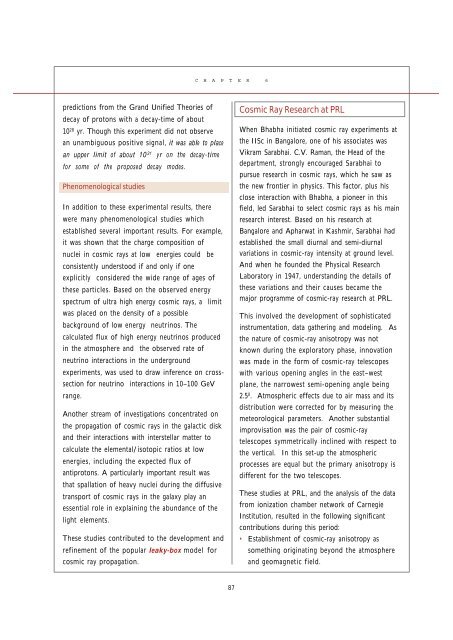2004 ASTRONOMY & ASTROPHYSICS - Indian Academy of Sciences
2004 ASTRONOMY & ASTROPHYSICS - Indian Academy of Sciences
2004 ASTRONOMY & ASTROPHYSICS - Indian Academy of Sciences
You also want an ePaper? Increase the reach of your titles
YUMPU automatically turns print PDFs into web optimized ePapers that Google loves.
CHAPTER 6<br />
predictions from the Grand Unified Theories <strong>of</strong><br />
decay <strong>of</strong> protons with a decay-time <strong>of</strong> about<br />
10 28 yr. Though this experiment did not observe<br />
an unambiguous positive signal, it was able to place<br />
an upper limit <strong>of</strong> about 10 31 yr on the decay-time<br />
for some <strong>of</strong> the proposed decay modes.<br />
Phenomenological studies<br />
In addition to these experimental results, there<br />
were many phenomenological studies which<br />
established several important results. For example,<br />
it was shown that the charge composition <strong>of</strong><br />
nuclei in cosmic rays at low energies could be<br />
consistently understood if and only if one<br />
explicitly considered the wide range <strong>of</strong> ages <strong>of</strong><br />
these particles. Based on the observed energy<br />
spectrum <strong>of</strong> ultra high energy cosmic rays, a limit<br />
was placed on the density <strong>of</strong> a possible<br />
background <strong>of</strong> low energy neutrinos. The<br />
calculated flux <strong>of</strong> high energy neutrinos produced<br />
in the atmosphere and the observed rate <strong>of</strong><br />
neutrino interactions in the underground<br />
experiments, was used to draw inference on crosssection<br />
for neutrino interactions in 10–100 GeV<br />
range.<br />
Another stream <strong>of</strong> investigations concentrated on<br />
the propagation <strong>of</strong> cosmic rays in the galactic disk<br />
and their interactions with interstellar matter to<br />
calculate the elemental/isotopic ratios at low<br />
energies, including the expected flux <strong>of</strong><br />
antiprotons. A particularly important result was<br />
that spallation <strong>of</strong> heavy nuclei during the diffusive<br />
transport <strong>of</strong> cosmic rays in the galaxy play an<br />
essential role in explaining the abundance <strong>of</strong> the<br />
light elements.<br />
These studies contributed to the development and<br />
refinement <strong>of</strong> the popular leaky-box model for<br />
cosmic ray propagation.<br />
Cosmic Ray Research at PRL<br />
When Bhabha initiated cosmic ray experiments at<br />
the IISc in Bangalore, one <strong>of</strong> his associates was<br />
Vikram Sarabhai. C.V. Raman, the Head <strong>of</strong> the<br />
department, strongly encouraged Sarabhai to<br />
pursue research in cosmic rays, which he saw as<br />
the new frontier in physics. This factor, plus his<br />
close interaction with Bhabha, a pioneer in this<br />
field, led Sarabhai to select cosmic rays as his main<br />
research interest. Based on his research at<br />
Bangalore and Apharwat in Kashmir, Sarabhai had<br />
established the small diurnal and semi-diurnal<br />
variations in cosmic-ray intensity at ground level.<br />
And when he founded the Physical Research<br />
Laboratory in 1947, understanding the details <strong>of</strong><br />
these variations and their causes became the<br />
major programme <strong>of</strong> cosmic-ray research at PRL.<br />
This involved the development <strong>of</strong> sophisticated<br />
instrumentation, data gathering and modeling. As<br />
the nature <strong>of</strong> cosmic-ray anisotropy was not<br />
known during the exploratory phase, innovation<br />
was made in the form <strong>of</strong> cosmic-ray telescopes<br />
with various opening angles in the east–west<br />
plane, the narrowest semi-opening angle being<br />
2.5 0 . Atmospheric effects due to air mass and its<br />
distribution were corrected for by measuring the<br />
meteorological parameters. Another substantial<br />
improvisation was the pair <strong>of</strong> cosmic-ray<br />
telescopes symmetrically inclined with respect to<br />
the vertical. In this set-up the atmospheric<br />
processes are equal but the primary anisotropy is<br />
different for the two telescopes.<br />
These studies at PRL, and the analysis <strong>of</strong> the data<br />
from ionization chamber network <strong>of</strong> Carnegie<br />
Institution, resulted in the following significant<br />
contributions during this period:<br />
• Establishment <strong>of</strong> cosmic-ray anisotropy as<br />
something originating beyond the atmosphere<br />
and geomagnetic field.<br />
87
















